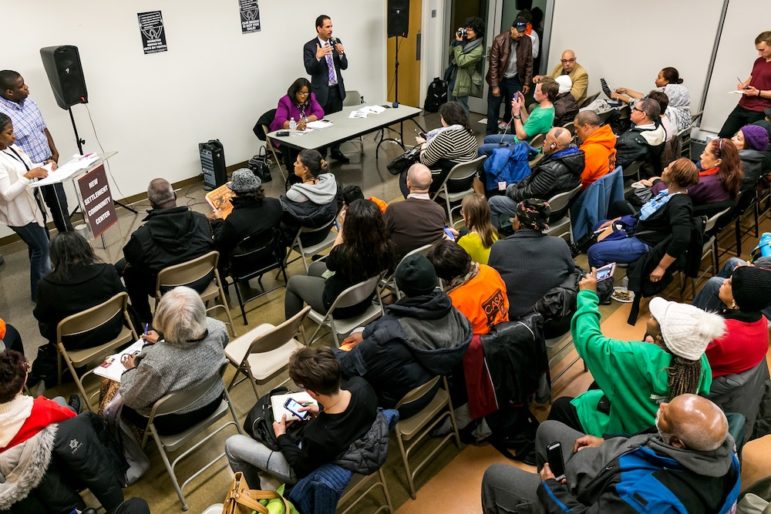
Adi Talwar
Councilmember Fernando Cabrera, with colleague Vanessa Gibson to his right, addresses the crowd at the New Settlement Community Center on Thursday night.
Two Bronx City Council members who will hold sway over the final shape of the proposed rezoning of Jerome Avenue committed to a wide range of policies supported by a coalition of community groups at a meeting on Thursday night, but stopped short of promising to vote no against the ultimate proposal if it fails to include all those measures.
As part of its plan to build and preserve 200,000 units of income-targeted housing over 10 years, the de Blasio administration has proposed rezoning a long corridor of Jerome Avenue in the Bronx to accommodate more residential space. Members of the Bronx Coalition for a Community Vision, which proposed its own redevelopment vision for the area, have raised concerns about the impact of the rezoning on low-income tenants and existing small businesses.
Councilmembers Fernando Cabrera and Vanessa Gibson, whose districts include part of the proposed rezoning footprint, took questions for more than an hour. They were asked about their commitment to a revised term sheet of city housing subsidies for extremely low-income people, about a “certificate of no harassment” program, the creation of an anti-displacement task force and what they plan to do about auto-displacement. They were asked to commit to supporting local hiring and apprenticeship programs. Their answers boiled down to support for the coalition’s positions (although there were differences: Cabrera, for instance, emphasized finding a place for auto shops to relocate if they are displaced by a rezoning, while Gibson focused on the fight to allow them to avoid that fate).
When asked (at about 1:12 in the video below) if they would push to delay the start of the city’s land-use review process (ULURP) if the coalition’s demands weren’t met, or even vote against the plan, the answers got more complicated.
“What I don’t like to do in most of my work is bet on a stack of cards and I don’t know what that deck looks like and where we are in the plan, we have seen very little detail from the administration,” she said. Noting the lack of public land in the Jerome area, Gibson said the local rezoning “is going to require us to do something different” from what was done in East New York.
She then expressed a willingness to delay land-use review, but a desire not to vote no.
“For me, your positions and your priorities that you have outlined and fought so hard for these past two years have become my positions. … If it means when we get to ULURP and we are not at the point—we, and when I say we I mean we, not just Fernando and I—where we are not able to support this particular plan in its particular form then absolutely I will support delaying ULURP. … I want to get it right … I don’t want to make any mistakes. I don’t want to leave anyone out. The city, I, none of us want this project to fail. I don’t want to get to a point where I have to say to my colleagues, ‘I want you to vote no on Jerome. I don’t want to do that.”
For his part, Cabrera suggested that maximum leverage would occur not by delaying ULURP, but by holding out to the last minute of that process. “The biggest leverage that we could ever have happens at the end,” he said. “At the very end, they’re going to have to give in.”
Watch it here:








